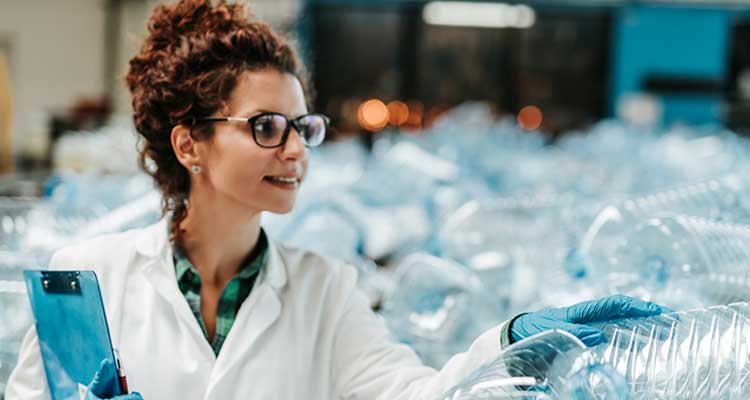Power Usage Efficiency
Will energy efficiency suffice for the energy transition? New solutions thanks to the circular economy
The impacts of climate change are becoming increasingly evident around the world. Extreme weather events such as heavy rain, drought, heat and forest fires are just a few examples of the consequences of climate change. The increasing scarcity of raw materials and critical infrastructure in the supply chain are also becoming glaringly evident – take, for instance, the exploding price of wood or the fact that a single cargo ship blocking the Suez Canal can collapse the entire semiconductor supply chain. In an era of climate change and a critical shortage of raw materials – a factor that is also being aggravated by the geopolitical situation – new solutions must be found.
Energy efficiency can play a part in the energy transition. However, this solution is no longer sufficient in the face of challenges that are becoming increasingly more complex. The focus on energy-efficient consumers needs to be extended to include regenerative energy production, energy storage and stable but flexible network structures. The R strategy reuse from the circular economy is also a promising approach.
The conversion to lighting with LEDs, the identification of energy-intensive consumers and the increase in efficiency of machines in production are current examples of energy efficiency measures that were put in place to make an important contribution to increasing efficiency within companies. However, in view of global crises such as the climate crisis and the scarcity of resources, energy efficiency no longer suffices as the sole solution. Genuine rethinking and alternative approaches have become imperative.
In politics and society, there is a growing movement to produce more sustainable and holistic products. The pressure from society is on the rise, through movements such as Fridays for Future or European legislation in the form of the Green Deal and the circular economy action plan. The tightening of the Circular Economy Act has led to requirements becoming progressively stricter in Germany. Rising external pressure is forcing more and more companies to operate more sustainably, which is translating directly into greater energy efficiency.
The circular economy (CE) is a possible solution to help companies become less dependent on critical resources and consequently more resilient in times of a crisis. The theory is that products should be designed from the very outset to last as long as possible and to be capable of being easily recycled or used for alternative purposes at the end of their life. Keywords, or R strategies, that are garnering ever greater attention are reuse, refurbish, remanufacture and recycle.
Our approach should now be to treat the crisis situation as an opportunity. Sustainable management must be taken into account when developing and manufacturing new products. The possible facets of this are manifold. This article will highlight two aspects as examples here.
Energy concept from regenerative energy production, energy-efficient consumers and energy storage
In many cases, energy-efficient machines are already being used in the manufacture of products. Most of the lighting in the industrial halls has been switched to LED lights. The current challenge is the generation of the energy used. Recent debates focus on the problem of generating energy from gas. This method of generating energy can also be improved in terms of the process itself and in terms of energy efficiency.
However, current discussions highlight that this will not be sufficient in the long run. It is important for companies to plan a comprehensive energy concept that incorporates regenerative energy production, energy-efficient consumers and energy storage at an early stage. In doing so, it is imperative to adjust the timing of energy production to the actual consumption.
Energy should only be generated when the consumer needs it, meaning adjusting the load to the generation and avoiding peak loads. There are intensive discussions revolving around the use of renewable energies such as photovoltaics and wind. The addition of photovoltaic systems (PV systems) is one possible solution for companies. Along with the south orientation, the east-west orientation of PV systems is of particular interest when consumers need electricity in the morning hours and late afternoon hours.
A storage system that makes excess energy available at another point in time should only be used in exceptional cases. It is also important to consider the electrical network and to design the energy concept in such a way that it stabilises the electrical network.
The circular economy and the R strategy reuse: application for the energy concept
In the circular economy, so-called R-strategies (reuse, refurbish, remanufacture and recycle) are used to move from linear management to circular management. Companies like GEA have found their way into the circular economy through a selection of R strategies. It is important to differentiate the strategies for products that are already being utilised by the customer and new products that are still being placed on the market. The R strategy reuse is presented below in the form of an example to demonstrate the enormous potential that exists.
As the name of the strategy suggests, the intention is to reuse the product. With respect to the energy concept mentioned above, consideration must be given to the components that can continue to be used in the energy system; energy-efficient products are of particular interest here. With this strategy, it is important to ensure the the quality of the components. One approach in the field of application-oriented research is the reuse of PV modules, particularly crystalline PV modules. The expiry of the EEG remuneration (after 20 years in Germany) is resulting in a steadily increasing number of PV modules becoming available for second-life use. To counteract the shortage of raw materials, other components of the energy system can also be reviewed to determine their viability in terms of a second life. The Institute for Technical Energy Systems (ITES) at the Bielefeld University of Applied Sciences is already experimenting with second life modules and preparing for application in the field.
The legal framework still remains a critical aspect. For example, e-waste cannot simply be reintroduced to the market as a new product in Germany, while the product guarantee also poses challenges. The legal framework for such reuse concepts needs to be adjusted and expanded accordingly to ensure successful and safe implementation.
Conclusion
- Energy efficiency is the building block of a scenario that needs to be considered in a larger context.
- A comprehensive energy concept is essential and must incorporate regenerative energy production and energy storage, in addition to energy-efficient consumers.
- R strategies from the circular economy such as the reuse strategy need to become an important component of the strategies pursued in companies.



